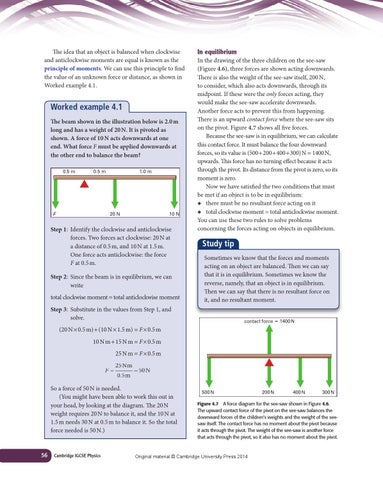The idea that an object is balanced when clockwise and anticlockwise moments are equal is known as the principle of moments. We can use this principle to find the value of an unknown force or distance, as shown in Worked example 4.1.
Worked example 4.1 The beam shown in the illustration below is 2.0 m long and has a weight of 20 N. It is pivoted as shown. A force of 10 N acts downwards at one end. What force F must be applied downwards at the other end to balance the beam? 0.5 m
0.5 m
F
1.0 m
20 N
10 N
Step 1: Identify the clockwise and anticlockwise forces. Two forces act clockwise: 20 N at a distance of 0.5 m, and 10 N at 1.5 m. One force acts anticlockwise: the force F at 0.5 m. Step 2: Since the beam is in equilibrium, we can write total clockwise moment = total anticlockwise moment
In equilibrium In the drawing of the three children on the see-saw (Figure 4.6), three forces are shown acting downwards. There is also the weight of the see-saw itself, 200 N, to consider, which also acts downwards, through its midpoint. If these were the only forces acting, they would make the see-saw accelerate downwards. Another force acts to prevent this from happening. There is an upward contact force where the see-saw sits on the pivot. Figure 4.7 shows all five forces. Because the see-saw is in equilibrium, we can calculate this contact force. It must balance the four downward forces, so its value is (500 + 200 + 400 + 300) N = 1400 N, upwards. This force has no turning effect because it acts through the pivot. Its distance from the pivot is zero, so its moment is zero. Now we have satisfied the two conditions that must be met if an object is to be in equilibrium: ◆ there must be no resultant force acting on it ◆ total clockwise moment = total anticlockwise moment. You can use these two rules to solve problems concerning the forces acting on objects in equilibrium.
Studyy tip p Sometimes we know that the forces and moments acting on an object are balanced. Then we can say that it is in equilibrium. Sometimes we know the reverse, namely, that an object is in equilibrium. Then we can say that there is no resultant force on it, and no resultant moment.
Step 3: Substitute in the values from Step 1, and solve.
contact force = 1400 N
(20 N × 0.5 m) + (10 N × 1.5 m) = F × 0.5 m 10 N m + 15 N m = F × 0.5 m 25 N m = F × 0.5 m F=
25 Nm 0 5m
= 50 N
So a force of 50 N is needed. (You might have been able to work this out in your head, by looking at the diagram. The 20 N weight requires 20 N to balance it, and the 10 N at 1.5 m needs 30 N at 0.5 m to balance it. So the total force needed is 50 N.)
56
Cambridge IGCSE Physics
500 N
200 N
400 N
300 N
Figure 4.7 A force diagram for the see-saw shown in Figure 4.6. The upward contact force of the pivot on the see-saw balances the downward forces of the children’s weights and the weight of the seesaw itself. The contact force has no moment about the pivot because it acts through the pivot. The weight of the see-saw is another force that acts through the pivot, so it also has no moment about the pivot.
Original material © Cambridge University Press 2014
